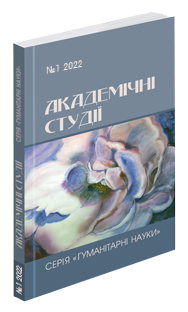Abstract
The purpose of the article is to compare phraseological units with the somatic component of Latin, German and Ukrainian languages. Methods. The work was dominated by elements of linguistic and descriptive methods, methods of synthesis and comparison. Ethnolinguistic analysis is used to determine the national significance of somatisms in language. Results. It is proved that phraseological units with a somatic component belong to the oldest layer of any language and have a symbolic characteristic. Analyzing the phraseological systems of comparative languages, the frequency of use of tokens-somatisms is determined. It was found out that the degree of frequency of somatism use differs significantly. Four tokens: eye, heart, head, hand was singled out and analyzed. The most frequent use and the widest range of values in the human existence of somatism рука / Hand / manus are recorded. It was found that the hand is a symbol of support of movement and protection of both physical and social nature; a measure of human strength. The token-somatism of the око / eye / Ohr carries the visual perception of the world and expresses emotions and feelings (love), as well as reflects beauty. It is determined that the somatism голова / caput / Kopf in Latin is less active. Expresses moderation, mental abilities, stupidity and moral impoverishment, as well as advocates the definition of the universe. The token серце / heart / cor reproduces the inner world of man, his positive and negative traits, as well as his balance and moderation. Conclusions. In the scientific investigation it was concluded that the Ukrainian and German phraseological units turned out to be more expressive and numerous. Analysis of phraseology with a somatic component confirmed that the semantic basis for the formation of phraseology is a symbol. The synthesis of body parts (hand, head, heart, eye) in speech systems has shown that the most productive somatisms are the hand and the eye. The token-somatisms head and heart in Latin do not all have equivalents.
References
Чаєнкова О. Фразеологічні одиниці із соматичним компонентом голова. Вчені записки Таврійського національного університету імені В. І. Вернадського. Філологія. Соціальні комунікації. Київ : Гельветика, 2020. Т. 31(70). № 2. Ч. 3. С. 141–146.
Тоненчук Т. Структурно-семантичний, ідеографічний та функційний аспекти соматичних фразеологізмів у сучасній англійській мові : автореферат дис. ... канд. філол. наук : 10.02.04 / Чернівецький національний ун-т ім. Ю. Федьковича. Чернівці, 2016. 20 с.
Решетова О. Фразеологічні одиниці з соматичним компонентом у мовній картині світу. Нова філологія. 2014. № 65. С. 67–71.
Кочеваткин А. Соматическая лексика эрзянского языка. Саранск : Красный октябрь, 2001. 200 с.
Пилипів О. Соматизми у фразеології латинської мови. Іноземна філологія. 2010. Вип. 122. С. 141–147.
Словник символів культури України / за ред. В. П. Коцура. Київ : Міленіум, 2002. 259 с.

